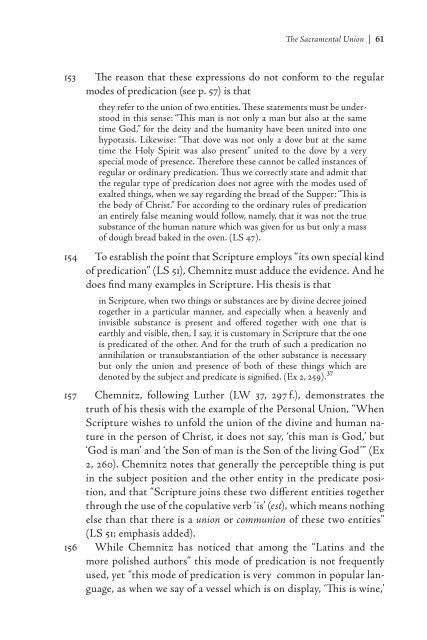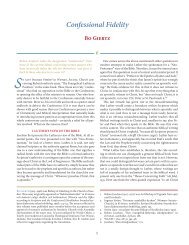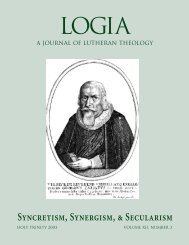The Lord's Supper in the Theology of Martin Chemnitz Bjarne - Logia
The Lord's Supper in the Theology of Martin Chemnitz Bjarne - Logia
The Lord's Supper in the Theology of Martin Chemnitz Bjarne - Logia
Create successful ePaper yourself
Turn your PDF publications into a flip-book with our unique Google optimized e-Paper software.
<strong>The</strong> Sacramental Union |<br />
153 <strong>The</strong> reason that <strong>the</strong>se expressions do not conform to <strong>the</strong> regular<br />
modes <strong>of</strong> predication (see p. 57) is that<br />
<strong>the</strong>y refer to <strong>the</strong> union <strong>of</strong> two entities. <strong>The</strong>se statements must be under-<br />
stood <strong>in</strong> this sense: “This man is not only a man but also at <strong>the</strong> same<br />
time God,” for <strong>the</strong> deity and <strong>the</strong> humanity have been united <strong>in</strong>to one<br />
hypotasis. Likewise: “That dove was not only a dove but at <strong>the</strong> same<br />
time <strong>the</strong> Holy Spirit was also present” united to <strong>the</strong> dove by a very<br />
special mode <strong>of</strong> presence. <strong>The</strong>refore <strong>the</strong>se cannot be called <strong>in</strong>stances <strong>of</strong><br />
regular or ord<strong>in</strong>ary predication. Thus we correctly state and admit that<br />
<strong>the</strong> regular type <strong>of</strong> predication does not agree with <strong>the</strong> modes used <strong>of</strong><br />
exalted th<strong>in</strong>gs, when we say regard<strong>in</strong>g <strong>the</strong> bread <strong>of</strong> <strong>the</strong> <strong>Supper</strong>: “This is<br />
<strong>the</strong> body <strong>of</strong> Christ.” For accord<strong>in</strong>g to <strong>the</strong> ord<strong>in</strong>ary rules <strong>of</strong> predication<br />
an entirely false mean<strong>in</strong>g would follow, namely, that it was not <strong>the</strong> true<br />
substance <strong>of</strong> <strong>the</strong> human nature which was given for us but only a mass<br />
<strong>of</strong> dough bread baked <strong>in</strong> <strong>the</strong> oven. (LS 47).<br />
154 To establish <strong>the</strong> po<strong>in</strong>t that Scripture employs “its own special k<strong>in</strong>d<br />
<strong>of</strong> predication” (LS 51), <strong>Chemnitz</strong> must adduce <strong>the</strong> evidence. And he<br />
does f<strong>in</strong>d many examples <strong>in</strong> Scripture. His <strong>the</strong>sis is that<br />
<strong>in</strong> Scripture, when two th<strong>in</strong>gs or substances are by div<strong>in</strong>e decree jo<strong>in</strong>ed<br />
toge<strong>the</strong>r <strong>in</strong> a particular manner, and especially when a heavenly and<br />
<strong>in</strong>visible substance is present and <strong>of</strong>fered toge<strong>the</strong>r with one that is<br />
earthly and visible, <strong>the</strong>n, I say, it is customary <strong>in</strong> Scripture that <strong>the</strong> one<br />
is predicated <strong>of</strong> <strong>the</strong> o<strong>the</strong>r. And for <strong>the</strong> truth <strong>of</strong> such a predication no<br />
annihilation or transubstantiation <strong>of</strong> <strong>the</strong> o<strong>the</strong>r substance is necessary<br />
but only <strong>the</strong> union and presence <strong>of</strong> both <strong>of</strong> <strong>the</strong>se th<strong>in</strong>gs which are<br />
denoted by <strong>the</strong> subject and predicate is signified. (Ex 2, 259). 37<br />
157 <strong>Chemnitz</strong>, follow<strong>in</strong>g Lu<strong>the</strong>r (LW 37, 297 f.), demonstrates <strong>the</strong><br />
truth <strong>of</strong> his <strong>the</strong>sis with <strong>the</strong> example <strong>of</strong> <strong>the</strong> Personal Union, “When<br />
Scripture wishes to unfold <strong>the</strong> union <strong>of</strong> <strong>the</strong> div<strong>in</strong>e and human nature<br />
<strong>in</strong> <strong>the</strong> person <strong>of</strong> Christ, it does not say, ‘this man is God,’ but<br />
‘God is man’ and ‘<strong>the</strong> Son <strong>of</strong> man is <strong>the</strong> Son <strong>of</strong> <strong>the</strong> liv<strong>in</strong>g God’” (Ex<br />
2, 260). <strong>Chemnitz</strong> notes that generally <strong>the</strong> perceptible th<strong>in</strong>g is put<br />
<strong>in</strong> <strong>the</strong> subject position and <strong>the</strong> o<strong>the</strong>r entity <strong>in</strong> <strong>the</strong> predicate position,<br />
and that “Scripture jo<strong>in</strong>s <strong>the</strong>se two different entities toge<strong>the</strong>r<br />
through <strong>the</strong> use <strong>of</strong> <strong>the</strong> copulative verb ‘is’ (est), which means noth<strong>in</strong>g<br />
else than that <strong>the</strong>re is a union or communion <strong>of</strong> <strong>the</strong>se two entities”<br />
(LS 51; emphasis added).<br />
156 While <strong>Chemnitz</strong> has noticed that among <strong>the</strong> “Lat<strong>in</strong>s and <strong>the</strong><br />
more polished authors” this mode <strong>of</strong> predication is not frequently<br />
used, yet “this mode <strong>of</strong> predication is very common <strong>in</strong> popular language,<br />
as when we say <strong>of</strong> a vessel which is on display, ‘This is w<strong>in</strong>e,’




